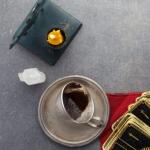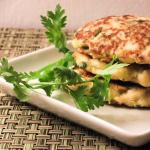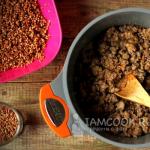I have been making currants only according to this recipe for more than 30 years. They turn out very tender, with soft skin, very aromatic, and when consumed, you can add sugar to your taste.
And for cooking we will only need the berries themselves, glass jars and lids for rolling. I have this jar in the photo from the year before last - it was perfectly preserved in an ordinary closet at room temperature.
The berries need to be washed well, then placed on a clean cloth and dried (I use disposable diapers for this purpose - I buy them at the pharmacy. Very convenient and no need to wash!)
First, let's wash and sterilize the jars. I wash them with baking soda, rinse them with hot tap water, put them in a cold oven on a wire rack, bottoms up, set the temperature to 180 degrees and heat the jars until the droplets of water disappear from them. Then I open the oven slightly and let them cool a little. , so as not to burst when filling. Then, while hot, but so that you can already grasp them with your hand, I fill the jars with washed and dried currants, put the jars in a large, tall saucepan (so that it is higher than the jars, I first place a clean cloth on the bottom), then I pour hot water from the tap into the pan so that it reaches the “shoulders” of the jar, but not higher, I close the pan with a lid and put it on the fire, bring it to a boil and reduce the heat so that it does not boil too much and the water does not get into the jars.. When heating, the berries will begin to settle and give juice, and we add berries to the jars as they settle until the jars become full and there is juice on top. Then we take out our jars one by one and roll up the lids boiled with baking soda. Then we turn the jars upside down up and leave until completely cool.
It is better to take small jars, no more than 1 liter in capacity, because... Opened currants are stored poorly and only in the refrigerator, but usually they are stored open for a long time and do not have to...
Place the opened currants in a bowl; their color is at first paler than that of the jam.

Then add sugar to taste (I like it sour) and mix and let stand until the sugar dissolves. The color becomes very pretty!!!

The taste turns out to be completely different from jam or cranked currants. No one likes jam and cranked currants, but they eat such currants with pleasure. This jar was completely accidentally lost in the closet, so I decided to post this wonderful recipe that I very helpful at a time when sugar was on coupons, we had our own dacha, and the dacha was full of berries that needed to be processed...

It is very tasty to use such currants in desserts, pie fillings, in drinks or just with tea.
Fruits and are the most popular among housewives. They are easy to prepare and store... Moreover, such preparations for the winter retain more nutrients than jams that take a long time to cook on the stove. So currants in their own juice are an excellent choice for those who love the taste and aroma of this healthy berry!
Ingredients:
- black currants – liter jar
- sugar – 1 glass

- No water is needed to prepare this preserve.
- Instead of black currants, you can use red or yellow ones: they will need the same amount of sugar.
Currants in their own juice preparation method:
1. Sort the currants - remove the green tails and leaves from each berry, if any. Rinse the berries well in a bowl, filling it with water several times and then straining the liquid through a colander.
Place the currants on a flat surface covered with a cotton cloth. The berries should dry completely on it, so it is better to lay the currants in one layer. It will take several hours for the berries to dry, so you can leave the berries on the cloth overnight.

2. Sterilize jars prepared for preservation. To do this, turn them upside down, place them in a pan of water, place screw caps next to them and boil for 10 minutes. To prepare the specified amount of currants, you will need three 300 ml jars, and one of them will only be auxiliary.
So, place one layer of sugar in three hot jars (cover the bottom of the jars with it).

3. Then place one layer of currants in the jars and immediately sprinkle them with sugar.

4. Fill the jars to the top in this way (you can even fill them with a slide), and sprinkle the rest of the sugar on top.
5. Line the bottom of a wide pan with a cotton kitchen towel to prevent the jars from hitting the metal bottom during cooking. Place all three jars of currants on a towel, cover them with lids (if you have arranged the berries in a heap, then cover the jars with the lids a little later, when the berries have squatted) and fill them with water up to the shoulders.

6. Boil the jars in a saucepan for 10 minutes, then remove them and seal the lids. Most often, the currants shrink too much during the heat treatment, so the berries from the third jar can be divided into two others.
Turn the hot jars upside down, listen carefully to see if they “squeak”, and then leave them on the table under a towel until they cool completely.
The currants are ready for the winter! How nice it will be to take out one of these jars on cold winter evenings and treat yourself to something sweet!
Good luck with your winter preparations!
Best regards, Victoria Dolgova.
Black currants ripen in July. This berry can be called a record holder for the amount of nutrients and vitamins it contains. How to preserve this storehouse of health for the winter? We offer several proven recipes
It is not for nothing that black currant received from scientists the official title of the healthiest berry. Everything from fruits to leaves is simply a storehouse of vitamins and medicinal substances. There is more vitamin A, which is responsible for healthy vision, in black currants than in carrots. In terms of the content of vitamin C, which can improve immunity, currants are the absolute record holder among cultivated plants. By eating only 20 fresh aromatic berries, you will cover your body’s daily need for vitamin C. Therefore, there is a reason to stock up on this miracle berry for future use in order to improve your health in the cold winter and fight vitamin deficiency in the spring. Another useful property of black currant is that it perfectly retains all its vitamin riches during storage. Here are several ways to prepare healthy berries.
Jam
Currant jam is a popular delicacy of all times. His recipe is simple and win-win. It seems that it is simply impossible to make currant jam poorly.
To prepare it, you will need berries and sugar in a ratio of 1 x 1. The sorted currants need to be washed in water, placed in a basin, covered with sugar and heated to a boil, periodically stirring the jam from the edges to the middle. Remove from heat without letting foam appear. Place the jam in sterilized hot jars, close the lids and roll up. Store cooled jam jars in a cool place.

Currants in own juice
Open a jar of currants like this in winter, and you will immediately be hit with the aroma of summer. From berries prepared in this way, you can quickly prepare a vitamin juice, you just need to add boiled water to the currants in their own juice.
For a 1 liter jar you will need a kilogram of currants and 4 - 5 teaspoons of sugar. The sorted berries need to be washed and dried. Place in clean, sterile jars, sprinkle with sugar. Cover with lids and sterilize for 15 minutes (time indicated for liter jars) in boiling water. Seal well.

Currants pureed with sugar
This method of preparing blackcurrants is called “jam without cooking.” The berry prepared in this way completely retains its taste and beneficial properties. Such “jam without cooking” should only be stored in the refrigerator or cellar.
For 1 kg of berries you will need about 2 kg of granulated sugar. Blackcurrants are sorted and washed. Pass through a meat grinder and mix with sugar until it dissolves. Place the berry mass into sterilized jars and cover with plastic lids.

Frozen currants
Frozen currants can be stored for more than one year without losing their beneficial qualities and presentation. Defrost the berry - and it will look like it just came from the bush! An excellent filling for pies and vitamin compotes in the middle of winter.
Only the best ones are selected for freezing: large and intact berries, washed and dried. Place on trays or special trays and place in the freezer. Frozen berries are poured into plastic bags made of thin cling film, sealed tightly and stored in the freezer. To properly defrost the berries, first put them in the general compartment of the refrigerator for 2 hours, and then defrost them at room temperature.

Dried berries and currant leaves
You can also dry currants and then add them to teas and make medicinal decoctions.
The berries are sorted, washed, dried and laid out in one layer on parchment paper on a baking sheet. Dry in an oven preheated to 60 degrees for 2 - 4 hours. Periodically you need to ensure that the berries do not dry out. The drying process is considered complete if the berries, squeezed into a fist, do not stick together. Drying currants in the hot summer sun is undesirable, as this destroys vitamins.

You can also dry currant leaves and buds. They are added to tea for aroma and benefits. Leaves and buds are dried in the shade, spread out on trays or baking sheets. And then stored in paper or fabric bags or boxes, protecting them from moisture.

ABOUT It is valued not only for its taste, but also for its high nutritional value. It contains a lot of vitamin C, vitamins B1, B2, PP, E, B-carotene, and many flavonoids. Blackcurrant is a good source of pectin; it contains a lot of potassium, calcium, magnesium, iron, phosphorus and copper. The predominant organic acids are citric and malic.
IN Berries contain few oxidative enzymes, so vitamin C is well preserved during processing. The combination of large quantities of vitamins C and P gives blackcurrant properties that allow it to be used in the prevention and treatment of atherosclerosis. It is able to stimulate appetite, stimulate bile secretion, inhibit putrefactive and fermentative processes in the intestines, and improve hematopoiesis.
L Black currant leaves are often used as an excellent seasoning when canning various vegetables. Blackcurrant processing products have excellent medicinal and dietary properties.
Storing blackcurrants (1)
ABOUT It is not a long-lasting product, but in a refrigerator it can be stored for up to 2-3 months. Berries intended for storage should be collected in dry weather, when the dew has subsided.
 |
 |
 |
Those collected after rain are not stored for long. It is better to collect currants in bunches. You can also pick the berries themselves, but in this case they must first be dried, scattered in a thin layer.
H Black currants should be stored in boxes, baskets, small boxes and plastic bags. Berries packed in boxes or baskets can be stored for up to 20 days. The optimal storage temperature is 0°C. Black currants can be stored in plastic bags at a temperature of 0-1°C for up to 30-45 days and at a temperature of minus 2°C for up to 3 months.
D For packaging, you can use ordinary household cling film bags with a capacity of 2-3 kg. The berries should be pre-cooled in the refrigerator and only then transferred to bags. If this is not done, then after cooling the currants in the bags will begin to sweat. Tie or seal bags of berries. During control inspections during storage, care is taken to ensure that they do not overripe. Overripe currants burst and release juice. Before eating, the berries should first be kept for several hours at a temperature of 4-6°C and only then brought to room temperature.
Storing blackcurrants (2)
IN In sunny weather, the berries on the bushes must be washed with a watering can or hose, allowed to dry, and treated with vodka on your hands and scissors. Immediately place the brushes into a sterilized bottle, shaking it occasionally. Seal the bottle filled to the top with a treated stopper and fill it with sealing wax or paraffin. Store in a cool, dry place at a temperature not exceeding 5-6°C in a horizontal position.
Natural black currant
ABOUT pick large berries, wash them and fill the jars with them up to the hangers. Fill the filled jars with boiling water and sterilize in boiling water:
- 0.5 l jars - 15 min
- 1 liter jars - 20 min
M You can also pasteurize it at 90°C - 20 and 25 minutes, respectively. These currants are used in winter for making compotes and jelly.
Currants in own juice
IN Wash large blackcurrants, dry and place in glass jars. Close them with lids, place them in a saucepan with water at room temperature, placing a wire rack on the bottom, and keep on low heat. When the water heats up, the berries will give juice, and the contents of the jars will decrease in volume by half. Pour the berries from two jars into one, cover with lids and heat again in a saucepan with water to 80-85°C.
Pasteurize:
- 0.5 l jars - 20 min
- 1 liter jars - 25 min
Z Then remove the jars from the water, seal with lids, turn upside down, and cool.
Blackcurrant without sugar and sterilization
P Place the prepared dry berries tightly in sterilized bottles, seal them with boiled corks, tie them with twine and fill them with sealing wax. Currants prepared in this way completely retain the taste, aroma and freshness of the berries. In winter you can use them to prepare compotes, juices, syrups, jelly, and pie fillings. It is necessary to store jars of fresh currants in the cellar or in the refrigerator.
Blackcurrant compote in its own juice or in apple (raspberry) juice
1. Place the prepared berries in jars up to their shoulders and pour in freshly prepared blackcurrant or apple (raspberry) juice, put on fire, cover with a lid and, stirring, keep at a temperature of 85°C for 5 minutes. Then fill hot sterilized jars right up to the lid and seal.
2. You can also fill the jars up to the shoulders with berries, pour in blackcurrant or raspberry juice, or juice from summer apples, and cover with lids. Then put the jars in a pan with cold water, bring to 80°C and hold:
- 0.5 l jars - 10 min
- 1 liter jars - 14 min
Z Then remove the jars, seal them with lids, turn them upside down, and cool.
Black currant berries in red currant juice
H Sort out the blackcurrants, wash them, place them in an enamel pan, pour in redcurrant juice, bring to a boil and simmer for 5 minutes.
TO Pour the boiling mixture into sterilized jars and seal.
Black currants in strawberry juice
H Sort out the blackcurrants, wash them, and place them in an enamel pan. Wash the strawberries, rub through a sieve or chop with a mixer.
P Pour the resulting juice and pulp over the blackcurrant berries, bring to a boil and simmer for 5 minutes. Pour the boiling mixture of juice and berries into sterilized jars and seal.
Blackcurrant berries in gooseberry juice
H Sort out the blackcurrants, wash them, place them in an enamel pan, pour in gooseberry juice, bring to a boil and boil for 5 minutes. Pour the boiling mixture into sterilized jars and seal.
Black currant berries in red beet juice
H Sort out the blackcurrants, wash them, place them in an enamel pan, pour in red beet juice, bring to a boil and boil for 5 minutes. Pour the boiling mixture into sterilized jars and seal.
Natural blackcurrant juice (1)
I crush the years with a wooden pestle, transfer to a saucepan, adding 1.5 cups of water heated to 80°C for each kilogram of mass. Heat the currants over low heat to 60°C and maintain at this temperature for 30 minutes. Then let the mixture settle, squeeze out the juice, remove the sediment and filter.
TO You can preserve it in two ways - depending on the size of the container. When bottling into jars with a capacity of 2 liters or more, juice should be preserved using the hot filling method. To do this, you need to heat the juice to 95°C and immediately pour it into jars so that it spills over the edges. Seal the lids, turn the jars upside down, and cool. Pour juice heated to 80°C into a small container. Then pasteurize the jars and bottles at 85°C:
- containers 0.5 l - 15 min
- containers 1 l - 20 min
Natural blackcurrant juice (2)
X Well sorted and washed berries are first boiled for 5 minutes, adding water. Squeeze the juice twice. After the first squeeze, mix the pulp by adding 1 glass of hot boiled water per 1 kg of squeezed pulp. If there is still a lot of juice left in the pulp after this, you can squeeze it a third time, adding water in the same proportion. After this, pour all the juice together, heat to a boil and pour into heated jars or bottles. Sterilize for 25-30 minutes. and seal.
Natural blackcurrant juice (3)
I rinse the years, drain, mince and steam. To do this, place a metal grid at the bottom of the tank, place an enamel pan on it, and on top an enamel colander filled with the resulting pulp. Pour a 6-8 cm layer of water onto the bottom of the tank, put the tank on the fire, cover with a canvas cloth, and tightly close the lid on top. The steam generated when water boils warms the pulp and promotes the release of juice, which gradually flows into the pan along with the water condensed from the steam. Duration of steam treatment is 2 hours.
P Pour the resulting hot juice into heated jars, cover with boiled lids and pasteurize at a temperature of 85-90°C:
- containers 0.5 l - 12 min
- 1 liter container - 15 min
- containers 3 l - 30 min
P After pasteurization, seal the jars, turn them upside down and cool. The juice yield from the feedstock is 42-44%. The remaining pulp can be used to make jelly and jelly.
Natural blackcurrant juice (4)
P Grind the prepared currants in a meat grinder (the diameter of the holes in the grid is 2.5 mm), place in an enamel pan, add water, heat to 70°C, hold at this temperature for 15-20 minutes. and press. Place the resulting juice in an enamel pan, let it sit for 2-3 hours and filter. Heat the filtered juice to 95°C, pour into dry sterilized jars, seal them, place them upside down, cover with a thick cloth and cool slowly.
ABOUT The remaining pomace can be used as follows: place in an enamel pan, add water (0.5 cups per 1 kg of pomace), leave for 4-5 hours, then press again. The juice obtained in this way can be used to make compotes, preserves and jam.
Natural blackcurrant puree
I Sort and wash the years, place in boiling water and steam under the lid for 2-3 minutes. While hot, rub through a sieve. Place the puree on low heat, bring to a boil, then immediately pour into hot jars and seal.
Frozen currants
ABOUT select large and undamaged berries, wash and dry, place in molds or on trays and freeze. Place frozen berries in plastic bags made of thin cling film, seal them and store them in the freezer.
Dried black currant
I Sort out the years, wash, dry and spread in one layer on sieves. Dry the currants at a temperature of 50-60°C for 2-4 hours, while making sure that the currants do not dry out. The process is considered complete if the berries, squeezed in a fist, do not stick together. Drying in the sun is undesirable - this destroys vitamins.
Go to section:
This is one of the fastest recipes that produces a real natural product. It is better not to use such preservation as a filling for all kinds of pies and pies.
Ingredients
- currants – 1kg
- sugar - 1 kg
Cooking method
- Before you start canning, be sure to sort out the berries and then wash the berries.
- Pour boiling water over jars up to one liter in volume. Place berries in them, sprinkling them with sugar. Do this so that the berry mass does not “dance” throughout the container; the layers should be dense.
- Send jars, covered with lids, for sterilization:
-Choose a dish with a wide bottom, which you can cover with a piece of cotton cloth or a towel.
-If several cans are placed in such a home sterilizer at once, try to ensure that they do not touch each other.
-Install the jars, and then pour water (room temperature) into the sterilization container so that it does not get inside the jars with the preparations.
-As soon as the water boils, the sterilization process begins, which will take 15 minutes for jars up to a liter in volume. - Then the jars need to be quickly screwed on with their lids. And be sure to turn it upside down. In this position, they are cooled and at the same time the quality of the twist is rechecked.
Ready! As soon as the jars have cooled, you can hide the currants in their own juice in a cold place, prepared for preparations awaiting the winter.


















